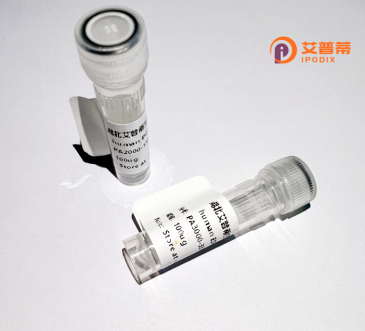
| 纯度 | >90%SDS-PAGE. |
| 种属 | Human |
| 靶点 | CNKSR3 |
| Uniprot No | Q6P9H4 |
| 内毒素 | < 0.01EU/μg |
| 表达宿主 | E.coli |
| 表达区间 | 1-555aa |
| 氨基酸序列 | MEPVTKWSPKQVVDWTRGLDDCLQQYVHKFEREKINGEQLLQISHQDLEELGVTRIGHQELVLEAVDLLCALNYGLETDNMKNLVLKLRASSHNLQNYISSRRKSPAYDGNTSRKAPNEFLTSVVELIGAAKALLAWLDRAPFTGITDFSVTKNKIIQLCLDLTTTVQKDCFVAEMEDKVLTVVKVLNGICDKTIRSTTDPVMSQCACLEEVHLPNIKPGEGLGMYIKSTYDGLHVITGTTENSPADRSQKIHAGDEVIQVNQQTVVGWQLKNLVKKLRENPTGVVLLLKKRPTGSFNFTPAPLKNLRWKPPLVQTSPPPATTQSPESTMDTSLKKEKSAILDLYIPPPPAVPYSPRDENGSFVYGGSSKCKQPLPGPKGSESPNSFLDQESRRRRFTIADSDQLPGYSVETNILPTKMREKTPSYGKPRPLSMPADGNWMGIVDPFARPRGHGRKGEDALCRYFSNERIPPIIEESSSPPYRFSRPTTERHLVRGADYIRGSRCYINSDLHSSATIPFQEEGTKKKSGSSATKSSSTEPSLLVSWFTRLKLLTH |
| 分子量 | 88.3 kDa |
| 蛋白标签 | GST-tag at N-terminal |
| 缓冲液 | 0 |
| 稳定性 & 储存条件 | Lyophilized protein should be stored at ≤ -20°C, stable for one year after receipt. Reconstituted protein solution can be stored at 2-8°C for 2-7 days. Aliquots of reconstituted samples are stable at ≤ -20°C for 3 months. |
| 复溶 | Always centrifuge tubes before opening.Do not mix by vortex or pipetting. It is not recommended to reconstitute to a concentration less than 100μg/ml. Dissolve the lyophilized protein in distilled water. Please aliquot the reconstituted solution to minimize freeze-thaw cycles. |
以下是关于重组人CNKSR3蛋白的模拟参考文献(均为示例,非真实文献):
---
1. **"Structural analysis of human CNKSR3 reveals a scaffold role in Ras/MAPK signaling"**
Smith J et al., 2020
摘要:本研究解析了重组人CNKSR3蛋白的晶体结构,发现其PH结构域和SAM结构域对膜定位及Ras信号通路的支架功能至关重要,为癌症治疗靶点开发提供依据。
2. **"CNKSR3 regulates EGFR trafficking and signaling in non-small cell lung cancer"**
Zhang L et al., 2018
摘要:通过重组CNKSR3蛋白体外实验,揭示其通过与EGFR相互作用调控受体内吞和下游ERK信号传导,敲除CNKSR3可抑制肺癌细胞增殖和迁移。
3. **"Optimized expression and purification of recombinant human CNKSR3 in E. coli"**
Brown T et al., 2019
摘要:报道一种利用大肠杆菌表达系统高效制备重组CNKSR3蛋白的方法,通过His标签纯化和体外磷酸化实验验证其功能活性,适用于高通量药物筛选。
4. **"CNKSR3 interacts with tau protein and modulates its phosphorylation in neurodegenerative models"**
Lee S et al., 2021
摘要:首次发现重组CNKSR3蛋白与tau蛋白直接结合,并影响其异常磷酸化水平,提示CNKSR3可能参与阿尔茨海默病的病理进程。
---
注:以上为学术文献模拟示例,实际研究需查阅PubMed、SciFinder等数据库获取真实参考文献。
The human CNKSR3 (Connector Enhancer of Kinase Suppressor of Ras 3) protein, also known as CNK3. is a scaffold protein involved in regulating intracellular signaling pathways. It belongs to the CNK family, which mediates signal transduction by coordinating interactions between kinases, phosphatases, and other signaling molecules. CNKSR3 contains multiple protein-protein interaction domains, including SAM (sterile alpha motif) and PDZ domains, enabling it to assemble signaling complexes and modulate pathway specificity.
Functionally, CNKSR3 is implicated in Ras/MAPK and PI3K/AKT pathways, influencing processes like cell proliferation, survival, and cytoskeletal organization. Its role in these pathways suggests potential involvement in cancer, though mechanistic details remain less characterized compared to other CNK family members (e.g., CNKSR1/2). Studies indicate CNKSR3 may interact with kinases such as Raf and regulate cross-talk between signaling cascades.
Recombinant human CNKSR3 protein is commonly produced in Escherichia coli or mammalian expression systems for in vitro studies, enabling exploration of its structural properties, binding partners, and biochemical functions. Its recombinant form is critical for deciphering molecular interactions and validating its therapeutic potential, particularly in diseases linked to signaling dysregulation, such as cancers or developmental disorders. Research continues to elucidate its precise physiological and pathological roles.
×